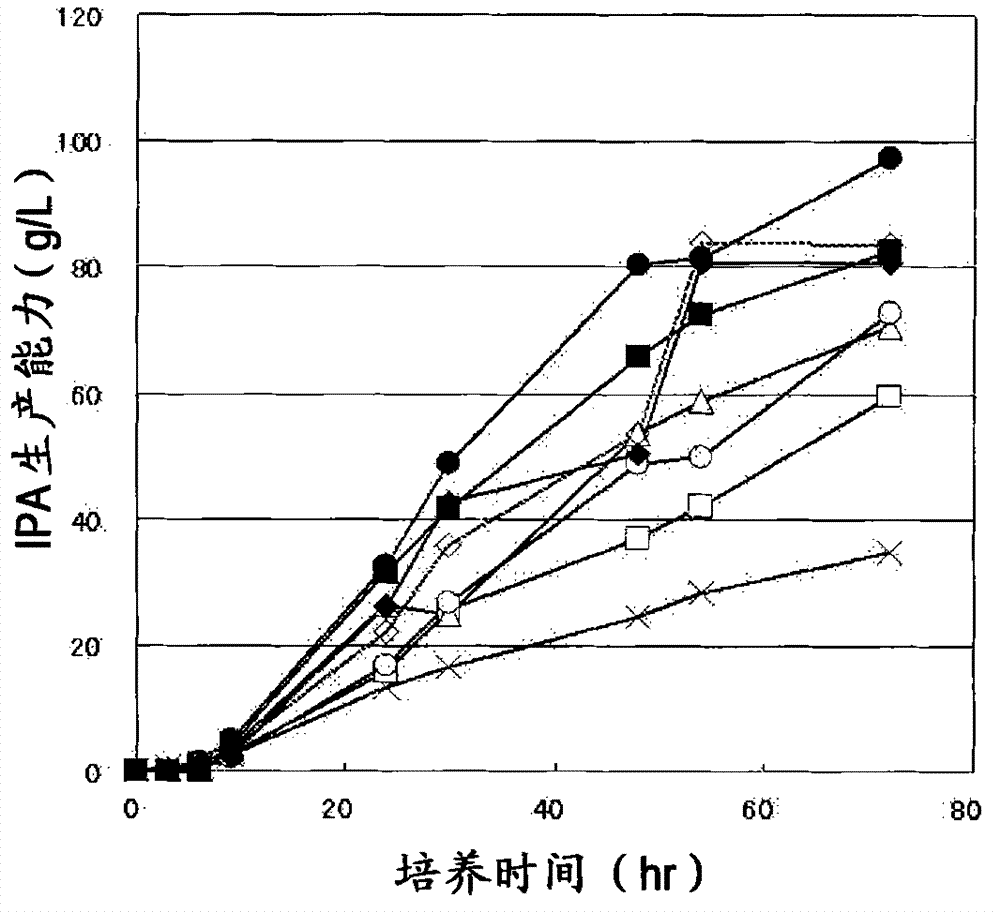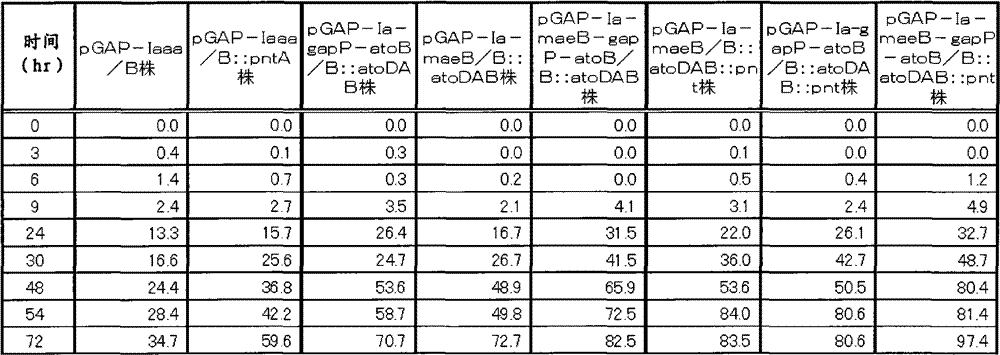Highly productive isopropyl alcohol-producing bacterium
A technology of isopropanol and isopropanol dehydrogenase, applied in the field of isopropanol-producing bacteria, can solve the problem that glucose cannot be completely inhibited
- Summary
- Abstract
- Description
- Claims
- Application Information
AI Technical Summary
Problems solved by technology
Method used
Image
Examples
Embodiment 1
[0119]
[0120] The pntA gene promoter on the genome of the Escherichia coli B strain was replaced with the GAPDH promoter to enhance the expression of the pntA gene.
[0121] The full base sequence of the genomic DNA of Escherichia coli MG1655 strain is known (GenBank Accession No. U00096), encoding NAD(P) of Escherichia coli + The base sequence of the gene for the α subunit of transhydrogenase (AB-specific) (hereinafter, sometimes abbreviated as pntA) has also been reported (GenBank Accession No. X04195). It is also known that pntA forms membrane transhydrogenase β subunit (pntB) and an operon on the genomic DNA of Escherichia coli MG1655 strain.
[0122]As the nucleotide sequence of the promoter necessary for the expression of the above-mentioned gene, the glyceraldehyde 3-phosphate dehydrogenase derived from Escherichia coli described in 397-440 in the nucleotide sequence information of GenBank Accession No. X02662 can be used (hereinafter, sometimes referred to as GAPD...
Embodiment 2
[0131]
[0132] As described below, making fortified NAD(P) + Expression of transhydrogenase (AB-specific) gene (pnt) in isopropanol-producing E. coli.
[0133] pGAP-Iaaa / B::pnt strain was obtained by transforming pGAP-Iaaa described in Example 4 of WO2009 / 008377 into the B::pnt strain prepared in Example 1. pGAP-Iaaa is an expression vector plasmid having the function of converting the E. coli-derived thiolase gene, E. coli-derived CoA transferase gene, Clostridium acetobutylicum-derived acetoacetate decarboxylase gene, and Clostridium beijerinckii Source The isopropanol dehydrogenase gene was strongly expressed using a promoter of glyceraldehyde-3-phosphate dehydrogenase (GAPDH) derived from Escherichia coli. The production method of pGAP-Iaaa is clearly described in Example 4 of WO2009 / 008377.
Embodiment 3
[0135]
[0136] CoA transferase genes (atoD and atoA) and thiolase genes (atoB) derived from Escherichia coli form an operon on the genome of Escherichia coli in the order of atoD, atoA, atoB (Journal of Baceteriology Vol.169 pp 42-52 Lauren Sallus Jenkins et al.), therefore, by changing the promoter of atoD, the expression of CoA transferase gene and thiolase gene can be controlled simultaneously. Therefore, Escherichia coli in which the promoter of the atoD gene on the genome of the host Escherichia coli was replaced with the GAPDH promoter and the expressions of the atoD, atoA, and atoB genes on the genome were enhanced was produced.
[0137] The complete base sequence of the genomic DNA of the Escherichia coli MG1655 strain is known (Genbank Accession No. U00096), and the base sequence of the gene encoding the α subunit of CoA transferase of the Escherichia coli MG1655 strain (hereinafter, sometimes abbreviated as atoD) There are also reports. That is, atoD is described...
PUM
 Login to View More
Login to View More Abstract
Description
Claims
Application Information
 Login to View More
Login to View More - R&D
- Intellectual Property
- Life Sciences
- Materials
- Tech Scout
- Unparalleled Data Quality
- Higher Quality Content
- 60% Fewer Hallucinations
Browse by: Latest US Patents, China's latest patents, Technical Efficacy Thesaurus, Application Domain, Technology Topic, Popular Technical Reports.
© 2025 PatSnap. All rights reserved.Legal|Privacy policy|Modern Slavery Act Transparency Statement|Sitemap|About US| Contact US: help@patsnap.com



